




ZUTARI'S
AWARDS 15 THE CRUCIAL ROLE OF DISPUTE RESOLUTION 27 HUSQVARNA'S ONESTOP EXCELLENCE 07 march 2024 | No 1179
SKA MEERKAT WINS MAJOR

contents and credits




contents
02 From the president’s desk
mbsa
02 Public procurement bill will "hinder"infrastracture delivery
04 Welcome aboard!
mba north
04 Executive director's review
05 MBA celebrating 120 years!
CoVEr storY
07 One-stop excellence
trEnds
10 Building sustainable battery giga factories
global ViEw
12 Collaborative water management: A path to Israeli-Palestinian peace
industrY nEws
15 Zutari's SKA MeerKAT Extension wins major awards
18 Energy plant and biomass optimisation in the timber sector
21 Saint Gobain: Nine-time global winner
22 Building Industry Bargaining Council's fair play driving Cape sector
FE aturE
24 Creating connection
PUBLISHER
Isikhova Media (Pty) Ltd
Tel: +27 11 883 4627
www.sabuilder.co.za
www.isikhova.co.za
CONTRIBUTIONS
Master Builders South Africa
Tel: +27 11 205 9000
E-mail: editor@sabuilder.co.za
www.masterbuilders.org.za
Free
projEC t managEmEnt
27 The crucial role of dispute resolution projEC ts
30 Kendal's Ash Disposal Facility nears completion
32 JDA's Orange Farm transport facility skills and training
34 Empowering tomorrow's engineers
businEss
36 Have you outgrown your payroll software?
produC ts
37 Big forks for all loads
38 Admixtures for every season
40 Debunking the myths about drywall in homes
innoVation
42 Off-site construction a key trend for 2024
44 Hydrogen meets Keller's gold mbsa
45 February is workplace violence awareness month
C aptains oF ConstruC tion
47 Richard Hugh: Straight chuter

Managing director: Imraan Mahomed
E-mail: imraan@isikhova.co.za
Sales director: Thuli Majola
E-mail: thuli@isikhova.co.za
Design and layout: Yoland Crator
E-mail: yoland@edgehosting.co.za
Copy editor: Anne Phillips
Advertising sales: Tel: +27 11 883 4627 Mobile: 072 383 3203/083 450 6052
march 2024 SOUTH AFRICAN b UILDER 01
South African Builder is the official journal of Master Builders South Africa, established in 1923. The opinions expressed by contributors are not necessarily those of Master Builders South Africa. SA Builder is a registered trademark of Master Builders South Africa. Any use of this trademark without the express and written approval of Master Builders South Africa is prohibited. No material contained herein may be reproduced in whole or in part without the prior written permission of the publisher. SA Builder © 2024. All rights reserved.
12 27 16 34
download
@Builders_SA
Facebook: @SouthAfricanBuilder savvy thinkers smart doers together people Proud Media Partner
available on: www.sabuilder.co.za Twitter:
|
message from the president
Master Builders SA (MBSA) welcomed Finance Minister Enoch Godongwana’s budget speech on 21 February 2024, particularly in relation to the introduction of fundamental and far-reaching reforms to infrastructure financing and delivery.
MBSA remain concerned about the declining infrastructure spending in the country. We are greatly perturbed when we see construction companies shutting their doors because the country does not have enough infrastructure projects to keep these entities active in competitive business.
The recently-released Quarterly Labour Survey for quarter 3 of 2023 paints a gloomy picture for the construction sector, which has shed thousands of jobs in just one quarter.
However, we reiterate our position that it is important for government to address all the inhibitors to
implementation of infrastructure spend, such as lack of state technical capacity to roll out the projects, delays in approving building plans, inability to deal with illegal construction site disruptions, non-payment of contractors and load-shedding, among others.

As an industry body, we remain committed to working with government to provide the required building skills for the country, since that is at the core of what we do for our members and the country. We avail ourselves as an industry body to collaborate with Godongwana and other relevant ministers to ensure that infrastructure delivery is fast-tracked.
Musa Shangase, President: MBSA
public procurement bill will “hinder" infrastructure delivery
South Africa cannot afford to have the new Public Procurement Bill signed into law in its current form because it will hinder, rather than support the infrastructure delivery challenges facing the country, warns Consulting Engineers SA (Cesa).
MBSA similarly believes there are serious challenges with the Bill in its current form, which is unconstitutional and susceptible to legal challenges, blurs the lines between the executive and legislature and gives the Minister of Finance unfettered power to make regulations beyond the mandate extended to him or her by the Constitution.
Cesa CEO Chris Campbell agrees, saying it is “highly likely” there will be a legal challenge to the Bill if it is passed into law in its current form.
Centralised control
“One issue our members have raised is that the role of
Treasury and the proposed Public Procurement Office have the impact of centralising procurement and stifling the independence of other organs of the state, state entities, public organisations and the municipalities,” says Mnisi.
He notes that the Public Procurement Office supplier database requirements are ambiguous and the process could be interpreted as granting the office discretion regarding registration on the supplier database.
The Bill has already been passed by the National Assembly and is now going through an approval process at the National Council of Provinces before being sent to President Cyril Ramaphosa to be signed into law.
The Public Procurement Working Group (PRWG), which comprises several civil society organisations, says the Bill will not achieve its
purpose, which is to create a single regulatory framework that gives effect to the Constitution in general and Section 217 in particular, as well as to create a public procurement system which is fair, equitable, transparent, competitive and cost-effective and serves as a foundation upon which the public procurement system will operate.
The PRWG says it is clear –from many research reports, academic articles and the Zondo Commission’s findings – that one of the primary causes of the dysfunctional state of public procurement in SA is the complex nature of the regulatory framework.
Campbell says that from an infrastructure delivery perspective, it cannot be sufficient for infrastructure to “be a mere mention in the definitions and one or two clauses” in the Bill in its current form. He points out that infrastructure, along with other
SOUTH AFRICAN b UILDER march 2024 02
items such as capital equipment, require more substance in primary legislation.
This aspect, he says, cannot be left to the regulations, particularly when Cesa has found that there is insufficient consultation with people who are knowledgeable in those areas when regulations are crafted.
MBSA goes further and claims that Section 217 of the Constitution requires that the legal framework be in the legislation and not the subsequent regulations.
public consultation
Campbell says although there was a public consultation process, there are indications that National Treasury did not look at many of the inputs that were received during this process, which makes the integrity of the process questionable.
He says public-sector officials in the procurement space indicated during personal discussions that they were also never consulted.
“This is a ground-breaking Bill for SA and one would have hoped that National Treasury would have gone to great lengths to get the input from the various entities at all the tiers of government, in order to ensure that legislation is applicable to all.
“This is because it will result in anything around procurement that comes out of the Public Finance Management Act and the Municipal Finance Management Act sitting in the Public Procurement Bill,” he says.
Campbell says t Cesa contends that it appears to be “an extremely hurried process” because a round of comments
went to National Treasury in 2020, but the Bill only resurfaced for discussion at the Nedlac forum in 2022, meaning that the social partners – business, labour and government – had only six months to go through it.
He is also unsure whether sufficient research was done even before the Nedlac process and points to the fact that SA’s neighbouring countries already have existing procurement legislation.
Mnisi says that MBSA in principle has no objection to government promulgating a law that will speed up procurement, since this is something the construction industry needs. However, he does not believe the construction sector, as a key industry involved in procurement, had sufficient opportunity to engage with government in the public consultation process, which was “very, very short”. He adds that the construction sector was only allowed to comment along “with everybody else, given the huge procurement in government that relates to infrastructure development”. A form of engagement specifically with the construction sector would have assisted with this.
priorities and objectives
Campbell says Cesa contends that the Bill in its current form will hinder, rather than support infrastructure delivery in SA, particularly as procurement will seemingly be done on who the lowest bidder is.
Procurement, he says, should be looked at from a much broader perspective, including deriving value for money and not necessarily gravitating to the least cost, but also factoring in the life-

cycle costs of infrastructure or a capital item.
“If you look at the section under preferential procurement, the shortcomings in this Bill will simply lead to more court challenges that then cause the process to come to a grinding halt,” he says.
Minister of Finance Enoch Godongwana referred to the Bill in his recent budget speech, but failed to mention any of the criticism of it. However, he admitted that government was “well aware that currently, procurement processes often fall short of delivering the most cost-effective solutions to government’s needs”.
“Too often, there’s a substantial disparity between the prices government is being charged and the prevailing market prices. Given that government buys in large quantities, we should be paying less and leveraging our buying power to get more value for our money,” he said.
“Obtaining value for money, as well as the principles of efficiency, transparency and competition, remain paramount. We want to assure South Africans that these principles aren’t incompatible with transformation,” he said.
Source: MoneyWeb, article written by Roy Cokayne
march 2024 SOUTH AFRICAN b UILDER 03 mbsa
Roy Mnisi.
mbsa
welcome aboard!
On behalf of all members, we extend a warm welcome to Zenzele Mabuza, our new occupational health and safety (OHS) manager.
He will be responsible for planning, directing and implementing a strategy for the provision of technical support associated with OHS matters. He will also analyse and formulate
mba north
comments on legislation affecting the construction sector.
Mabuza will be representing MBSA on various external committees, such as BUSA and the SA Council for the Project and Construction Management Professions. In addition, he will arrange and manage the judging of the Annual National OHS Competition.
We look forward to working under his leadership and direction.

executive director's review
Building and construction continue to be one of the highly constrained sectors of our country’s economy. Therefore, as an association, we are a mirror image of what takes place in our industry. The year 2023 was one of the most challenging years experienced by the association. Having survived the ordeal of Covid-19 very well, we are now starting to feel the impact thereof very seriously.
Although we continue to attract and recruit new entrants or new members, it is certainly at a far slower pace than we have experienced before. The sad part, however, is that we also continue to see a loss of longexisting and well-established main contractors of our membership through liquidation. What is most devastating is that these companies have lost legacies they had been building for many years and their employees have lost whatever means these companies
were giving them to help sustain their families. We salute these companies that have contributed so much to the SA building industry for so long.
A number of our sub-contractors have also had to close their doors due to the liquidation of main contractors, the scarcity of construction projects and many other reasons. Some have also had to cancel their membership with the association. The association lost a great number of member subscriptions in 2023 and, unfortunately, terminated close to 200 members who had been indebted to it for more than two years. This left the association with a deficit of R1,5 million on annual member subscriptions. The association started a subscription collection drive which took place in May-June and we were able to collect close to R800 000, moving us from a deficit of R1 500 000 to R700 000 on annual member subscriptions.
Despite the tough year, our CHS department, under the leadership of Gerhard Roets, performed exceptionally well in 2023 and it exceeded its annual budget/ target by R500 000. This carried the association, and we give thanks to members like TriStar Construction, JC van der Linder Venter, ENZA Construction, Edelweiss Aluminium, etc who continue to support us by using our CHS services. We wish to encourage all our members to use our affordable CHS, Legal and Contractual and Training services. We also encourage our members who have their own CHS departments to use the association for their external audits so that they have an independent view and perspective on their sites.
The association also successfully hosted big events like the MBA North Annual Golf Day and the combined MBA North CHS Awards and annual dinner, where
SOUTH AFRICAN b UILDER march 2024 04
Zenzele Mabuza.
we celebrate all our members for their efforts and dedication to compliance, as well as all our longstanding members, stakeholders, partners, sponsors and the MBA North team. We also participated in stakeholder engagements, where the team and I attended the FEM Safetember, First Thursday hosted by TriStar, Tiber & Washirika 3 Oaks Best Projects events, Construction World hosted by AfriSam and the Department of Employment and
Labour Conference, etc. We will always support our stakeholders and partners wherever we can.
Our focus for 2024 is to continue fighting for the well-being of our members and that of the industry and to continue being a solution-based association for our members, building strong and valuable relations with them and ensuring that we eliminate any delays and hurdles that may prevent them from continuing
to build SA. I express my deep gratitude to all members of MBA North, the office-bearers and the Executive Committee for their unwavering support and last, but not least, my thanks to the MBA North team for working tirelessly to give value to members and elevate the association to greater heights.
MOHAU MPHOMELA
Executive director: MBA North
mba north celebrates 120 years!
“Our industry of building and construction continues to be one of the highly constrained sectors of South Africa’s economy. Therefore, as an association, we are a mirror image of what takes place in our industry. 2023 was one of the most challenging years experienced by the association. Having survived the ordeal of Covid-19 very well, we are now starting to feel the impact thereof very seriously on what was an already constrained sector prior to that world pandemic.” These were the sentiments echoed


by executive director Mohau Mphomela, as MBA North hosted its 120th annual general meeting (AGM) on 1 February 2024.
Mphomela added that although we continue to attract and recruit new entrants or new members,
it is certainly at a far slower pace than we have experienced before. Unfortunately, we also continue to see a loss of longexisting and well-established main contractors of our membership through liquidation, with the most devastating part being that these
march 2024 SOUTH AFRICAN b UILDER 05
mba north
(Above): Inauguration of Liana van der Walt as the incoming president of MBA North.
mba north
companies have lost legacies which they had been building for many years. Despite the recent tough years, the association’s CHS department performed exceptionally well and he encouraged members who have their own CHS departments to use the association for their external audits, so as to ensure that they have an independent view and perspective on their sites.
The AGM celebrated 120 years of existence of MBA North and saw the inauguration of a new president and vice-president for the association, Liana van der Walt and Gavin Morrow respectively, as the term of the outgoing president, Sello Mokowane had come to a close. Mokawane stressed that the industry

continues to face immediate challenges, such as lack of projects and scarcity of work opportunities, the persistent issue of site disruptions by business forums and issues of payment guarantees, among many others. As he handed over the reins to the

incoming president, he committed to continue serving as an officebearer and ensure the ongoing pursuit of these critical issues affecting the construction industry.
Another highlight at the AGM included the acknowledgment of Pieter Rüde as an honorary life member who has diligently served the association over a period of 25 years through meaningful influence, continuous participation and giving of himself to the association. MBA North recognised the time and resources he has dedicated to the association and saluted him for embodying its vision through his service, which has immensely contributed to its success. As he thanked Rüde, Mphomela noted that MBA North’s focus for 2024 is to continue fighting for the well-being of the industry and to remain a solution-based association for our members, building strong and valuable relations, and ensuring that we eliminate delays and hurdles that may prevent the continuous building of South Africa.
06 SOUTH AFRICAN b UILDER march 2024
(Above): Acknowledgement of Pieter Rüde as an Honorary Life Member of MBA North.
(Above): Inauguration of Gavin Morrow as the incoming vice-president of MBA North.

one-stop excellence
Not many companies can boast a history dating back to the 17th century. Yet Husqvarna, which had its beginnings as a weapons foundry called Husqvarna Vapenfabriks Aktiebolag in the eponymous Swedish town in 1689, gradually expanded its interest into sewing machines, hunting weapons, wood stoves, meat mincing machines, the first Swedish typewriter and bicycles. By the 20th century, it was also producing motorcycles and outdoor products and today, as a sprawling global organisation, it is still driven by its 325-year-old reputation for uncompromising excellence.
Today the Husqvarna head office is in Jonsered, Sweden, and has factories in Europe, North America, China and India, as well as a global network of sales companies, service centres, distributors and rental companies. With total net sales in 2022 of SEK8,2 billion, it has 2 700 employees.
The organisation has long been a leader in supplying an exceptionally wide range of machinery for the preparation of floors and walls, with products ranging from power cutters to floor saws, tile and masonry saws, wall saws, wire saws, early-entry
saws, compactors, floor scrapers, shot and steel blasters, floor scarifiers, shavers and grinders, power trowels, demolition equipment, dust and slurry equipment and power packs, among many others.
Richard Hugh, sales manager: Africa for Superb Flooring / Construction Systems (which is part of the PMSA Group), says these have been the core specialty of Husqvarna Superb Flooring Systems since 2017, when Husqvarna acquired the HTC brand and became its sole agent in sub-Saharan Africa, as well as for Husqvarna concrete floor
march 2024 SOUTH AFRICAN b UILDER 07 cover story
Husqvarna’s DXR range of demolition robots, which protect operators from falling rocks and rubble, as well as from intense heat.
cover s tory
machinery and diamond tools. Today, as a specialised flooring contractor, it supplies basic and smaller machinery to flooring construction companies for the residential market, as well as large machines for the industrial sector.
“Generally, the more popular floor-grinding machines are used for all sorts of flooring preparation tasks, such as tile and tile glue removal, preparation before epoxy and polyurethane coatings, etc. However, given the current financial climate, floor-owners are looking for more economically feasible flooring systems which are also more cost-effective and durable alternatives to coatings and coverings,” says Hugh. “Tiles, epoxies and vinyls all have a shelf life. By installing a Husqvarna Superfloor, which is the global standard of polished concrete with Husqvarna’s range of professional machinery and contractors, a floor’s lifespan can extend its durability in some cases for the entire lifetime of the building, with minimal maintenance.”
two companies, one mission
“PMSA has now established two companies for different areas of specialisation, although they both subscribe to the same standards of excellence in all their products and ancillary services. The first is Superb Flooring Systems, which is the sole distributor of Husqvarna/HTC and Blastrac surface preparation and concrete polishing systems in sub-Saharan Africa. The second one, Superb Construction Systems, is the sole distributor in South Africa and
offers a comprehensive machinery range, supplying everything from diamond tools to rollers, compactors used for preparing earthworks and civils before applying concrete. It also offers concrete placement machinery for four or five different industrial segments, civils, vibrators for casting and power floaters for smoothing concrete, as well as machinery for cutting and coring concrete when drillholes are needed in floors to lay electrical cables or pipes,” says Hugh.
He is particularly proud of one of the company’s newest light pedestrian walk-behind rollers, the LP6500. “Husqvarna has been
offering rollers for some time. However, it’s now developed the LP6500, which is specially made for the world’s emerging markets in Africa, the Middle East, India and South America. It’s a little more basic – and a lot more affordable – than the previous range of machines, as well as more durable. Therefore, it’s ideally positioned for clients working on projects with comparatively constrained budgets,” explains Hugh.
“We also have the very wide DXR range of demolition robots that are particularly suited for mining and other heavy industrial areas. They have robotically controlled

SOUTH AFRICAN b UILDER march 2024 08
Husqvarna’s newest light pedestrian walk-behind roller, the LP6500.
arms and other accessories attached on a track and are able to break anything – from tunnel walls to rubble – at a distance from the operator, who’s therefore protected from falling rocks, as well as heat. This is an important advance in safety for the mining industry, where such accidents are common and fatal,” he says. “What’s more, by giving workers greater confidence and reassurance, they boost productivity.”
planet-friendly performance
Environmental responsibility and sustainability are high among Husqvarna’s priorities, as exemplified by innovative products such as X-Torq®, which
delivers higher fuel-efficiency and reduced exhaust emission levels in mainly hand-held products, in accordance with the world’s most stringent environmental regulations; AutoTune™, a technological and environmental breakthrough in professional chainsaws minimises exhaust emissions and maximises engine performance, eliminating the need to spend time making carburettor adjustments; lightweight, quiet, battery-powered mowers and chainsaws which are free from direct emissions; and robotic self-operating mowers, which also produce no direct emissions and consume very little energy.
In line with its status as the complete partner to both the
flooring and building industries, Husqvarna also offers a range of supportive services for construction sites, offices and workshops, including financing, fleet management, service contracts, on-site advice, training, assistance and workshops for users of its products. “We take responsibility for all machines once they’ve left the floor,” says Hugh.
“Husqvarna is the market leader for pretty much every machine it manufactures and distributes, thanks to our reputation for excellence.” .
PMSA Group
12 Graniet St, Jet Park
Boksburg, Gauteng
Tel: 011 578 8700
Website: https://pmsa.com

march 2024 SOUTH AFRICAN b UILDER cover story 09
Husqvarna’s range of self-propelled floor saws, including the FS 7000 D in front.
building sustainable battery giga factories
By Peter Hodgkinson, director for strategic growth and major projects: Property & Buildings, WSP in Africa
Battery giga factories have a critical role to play as more countries and industries embark on meeting net zero targets and transitioning to renewable energy sources. Access to more efficient, scalable and environmentally sustainable battery manufacturing capabilities will assist stakeholders achieve these objectives faster.
The race for battery giga factories underscores the need for countries to rapidly acquire capabilities to maintain and grow their capacity. Three core markets are driving the growth of battery manufacturing – battery energy storage solutions, electric vehicles and consumer electronics (think rechargeable appliances).
b attery manufacturing boom
Currently, there are 360 giga factories in the pipeline around the world to finish by 2030. Not too long ago, that number was only 115.
The global demand for batteries is expected to increase from 185GWh in 2020 to over 2 000GWH in 2030. Furthermore, the value of the worldwide lithium-ion battery market size
is projected to top $193 billion by 2028, reflecting a 23,3% compound annual growth rate from 2021. This has proven to be the catalyst for the construction of sustainable and efficient battery giga factories.
According to research, investments in battery giga factories hit $131 billion in 2022, a 24% increase over the previous year. These were predominantly led by China. However, North America is catching up, with its manufacturing capacity expanded by 49% in 2022, comparing strongly with China’s 65% year-onyear increase.
m odifying existing facilities
From new builds to refurbishing and converting previously used manufacturing facilities, or expanding existing traditional battery manufacturing facilities to giga factories, securing these investments requires a holistic approach that encompasses construction, optimisation, power supply, site selection, feedstock sourcing, sales strategy, regulatory compliance and a sustainability lens.
Fortunately, existing facilities may be retrofitted to transform into battery giga factories through an integrated approach that seeks to re-use as much of

the existing buildings, services and equipment at the facility as possible, even if there are limitations of the host building. It should be noted, however, that the plants themselves are technically complex, requiring deep knowledge in the new generation of giga factories, as well as specialist expertise in clean and dry room design and implementation.
m inimising risk
In managing risks for retrofitting facilities into battery giga factories, thorough studies are essential. This includes geotechnical and environmental assessments, evaluating flood risks considering climate change and checking for ground
“aiming for net zero targets.”
SOUTH AFRICAN b UILDER march 2024 10
trends
(Right): Peter Hodgkinson, director for strategic growth and major projects: Property & Buildings, WSP in Africa.
contamination. Identifying materials such as asbestos and conducting concrete integrity testing is critical to gauge the effects of age and chemicals.
A documentation search is also vital. This should encompass existing drawings, reverse engineering and reviewing maintenance records by consulting with on-site personnel and third-party vendors. Ensuring safety for structural and civil aspects of the construction, as well as mechanical and electrical services, is important. Building information modelling enhances upfront planning and coordination within the model space, which is fundamental in reducing risks and ensuring an efficient project timeline.
i mproving the energy-efficiency of an existing facility
A fundamental question to address is how to improve the energy-efficiency of an existing factory. This is where developing sustainable battery giga factories requires a combination of international experience with local insights.
Working with the permitting and local authority on establishing site boundaries and zoning rights, while also maintaining compliance with national and local regulations, is vital. So, too, is recognising the
environmental conditions of where the current facility is situated – eg, the humidity, the climate and the impact of climate change.
Decision-makers must be aware that the building typically accounts for less than one-third of construction capital expenditure, while services and utilities constitute the majority. They must therefore understand the cost implications of alterations, which may make greenfield projects potentially more cost-effective than brownfield ones.
Enabling a sustainable future
Keeping circular economy principles in mind is vital to ensuring that battery manufacturing plants support the project and business’s environmental, social and governance goals. This includes looking at solutions for design out waste and pollution, for example, while keeping products and materials at their highest possible value, and regenerating natural systems. This helps to drive clean growth, preserve natural capital
and reduce waste, achieve net zero goals, reduce cost and improve industrial resilience. The goal is to eliminate value leakage across the resource lifecycle, while creating industrial symbioses and regenerating natural capital.
Additionally, looking at the lifecycle of giga factories through a sustainability lens means not only targeting efficiencies of the design and building of these facilities, but also ensuring that they continue to operate as efficiently and sustainably as possible. Continuous monitoring and identifying opportunities to improve the life-cycle management of these factories supports these aims, in the wake of evolving technologies and market demands.
Battery design, and therefore the design of battery giga factories, is a rapidly evolving industry To truly drive industry growth, it is essential to embrace innovation, achieve future-readiness and prepare for the changing landscape. Ultimately, the emergence of battery giga factories will help the world embrace a more sustainable future, while still meeting the demand for these precious commodities.
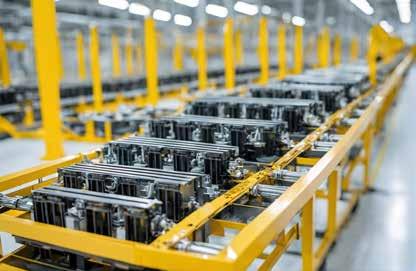
march 2024 SOUTH AFRICAN b UILDER 11 trends
collaborative water management: a path to israeli-palestinian peace
The Middle East is an arid region which is highly vulnerable to the effects of climate change. There is an essential need for solutions that offer equitable access to water and sanitation, and that protect Israel and the Palestinian territories’ shared water resources.
a dry region with a growing population
Israelis and Palestinians living in Israel, Gaza and the West Bank have a combined population of roughly 14 million. Both
populations are growing at nearly 2% annually, compared with 0,4% per year for high-income countries. As the populations grow, so does the demand for water.
The average yearly per capita water supply for the region is less than 500m3 /per capita. According to the UN and other experts, this amount is at the upper threshold of absolute water scarcity – the level at which nations cannot meet all demand, especially the large amounts needed for agriculture,
and have to restrict water use. For comparison, in 2015 the USA used 1 207m3 /per capita of water.
Israel and the Palestinian territories’ main freshwater resources are the Jordan River system and two groundwater aquifers – one along the Mediterranean coast and the other beneath the central Judean mountain range. Palestinians in the West Bank have access mainly to the mountain aquifer system, while those in Gaza use the coastal aquifer. Israel uses both.

Water is a central element of the war between Israel and Hamas in the Gaza Strip. Israel controls several water pipelines entering Gaza, but water can also be a source of hope for an alternative future.
12 SOUTH AFRICAN b UILDER march 2024 global view
u nequal access to water
Since the foundation of the state of Israel, access to water resources has been as central to the nation’s conflict with the Palestinian people as competing claims to land. Israel has partially decoupled itself from water scarcity by building desalination plants along the Mediterranean coast.
In the West Bank, Israel’s continued occupation has impeded Palestinians’ ability to develop their own water network that could distribute water across the population. The situation in Gaza is even more dire.
Even before the current IsraelHamas war, Gaza had a massive water deficit. Its main source is groundwater, which has been significantly over-pumped and is now so salty as to be undrinkable due to seawater
intrusion into the aquifer. Before the war, most Gazans relied on private water vendors and a few small desalination plants for drinking water. Israel also piped about 10 million cubic metres of water each year into Gaza. Yet, all told, the water supply is not large enough to meet the entire population’s needs. Now, because of the war, no fuel is entering Gaza to run the desalination plants, leaving them inoperable.
Israel has turned off water and fuel shipments to Gaza in order to punish Hamas. This strategy has turned a disaster into a catastrophe that is only likely to get worse.
It is unlikely that the lack of access to drinking water and sanitation will cause Hamas to lay down its arms. However, it is already bringing additional misery to the civilians of Gaza and giving

them further reason to hate Israel, and will add to international condemnation of that country.
UN officials are warning that lack of water and sanitation will precipitate an enormous health crisis which will particularly affect women and children. It could lead to outbreaks of waterborne diseases that will spread rapidly across Gaza’s crowded and besieged population.
Gazan hospitals are already overwhelmed with casualties and lack water and electricity.
Collaborative water projects
Studying approaches to managing water and other environmental resources, the Arava Institute for Environmental Studies is a non-profit teaching and research centre in the south of Israel. At the institute, students and academics from Israel, the Palestinian territories and Jordan come together to learn from each other and work together, developing technologies and programmes that meet the region’s water needs. This collaboration creates understanding and friendships which defy the ongoing conflict.
From 2019-2023, the Arava Institute has worked together with a Palestinian non-profit group, an Israeli water tech company called Watergen and the Friends of the Arava Institute, a USA-based non-profit, to install seven atmospheric water generators in Gaza. These devices, which pull humidity from the atmosphere and turn it into highquality drinking water, run on solar
13 march 2024 SOUTH AFRICAN b UILDER global views
A view of the project
global view
power to ensure round-the-clock operation in the energy-poor Gaza Strip.
The institute also installed the first generator in a small municipality in central Gaza, along the border with Israel, in 2019. The second, larger generator was installed in a major hospital in central Gaza in 2020. During the hostilities between Hamas and Israel in May 2021, when water supplies were cut off to many communities, these generators were the only sources of drinking water for many people in the surrounding communities.
In 2023, funds were raised to install five more water generators at medical facilities throughout Gaza. According to David Lehrer, director of the Arava Institute’s Track II Environmental Forum, two generators in southern Gaza are still working and are the only sources of clean drinking water in the region. The fate of the other units is unclear.
In a separate project in 2020, Arava and its Palestinian

partners installed a pilot mobile wastewater treatment plant in a Gazan village. The plant treats 100m3 of wastewater per day, serving around 1 000 residents, and produces treated wastewater which is of sufficiently high quality to be used in agriculture. It is estimated that about 25 of these mobile treatment plants could cover all of the village’s needs.
Many rural villages in Gaza have no centralised wastewater treatment system. Wastewater is collected in unsanitary cesspits in the middle of the road between houses. Raw sewage runs in open ditches from homes to the cesspits, which residents pump out around once a month.

Sewage then would normally be transported to a wastewater facility to be treated. However, now, because of the war, without fuel for electricity, wastewater plants in Gaza are not working. Raw sewage is being dumped into ecologically important coastal wetlands
called wadis and into the Mediterranean Sea.
This environmental and public health catastrophe also affects Israel. The Israeli seawater desalination plant in Ashkelon is only a few kilometres north of Gaza and cannot operate if it risks pulling in polluted seawater. Over the years, lack of adequate sewage treatment in Gaza has caused the plant to periodically halt operations.
Working closely with Israeli and Palestinian partners is not easy. People from both sides have histories of trauma and grief and, in most cases, very little experience of each other. However, working together on shared water challenges can bring people together.
An alternative future is possible – a future that is grounded in a sense of shared humanity and respect. Indeed, we believe it is the only future that is possible for the intertwined reality of Israelis and Palestinians.
SOUTH AFRICAN b UILDER march 2024 14
(Above, from left): Clive Lipchin (adjunct professor of environmental studies, Tel Aviv University) and Richard Friend (senior lecturer in human geography, University of York, UK).
(Above): Weaponising water – one of the most crucial requirements of both warring sides.
Reprinted with permission of Infrastructure News.
zutari's ska meerkat extension wins major awards
Leading consulting engineering and infrastructure advisory firm Zutari has clinched top industry awards for its work on the MeerKAT Extension for the SA Radio Astronomy Observatory (SARAO) and the ConcorOptiPower Consortium. The project saw 24 dishes added to the current MeerKAT Array and the establishment of the SKA-MID Array’s first dishes.
Upon completion, the Square Kilometre Array telescope near Carnarvon in the Northern Cape will be the world’s largest radio astronomy telescope, allowing scientists to map the universe with more sensitivity and speed and over greater distances. This will enable transformational science to enhance our understanding of the universe.
Zutari clinched a win for its work in the category for projects from R50 million-R250 million at the CESA Aon Awards 2023 on 16 August 2023. It subsequently received a commendation for Most Outstanding Civil Project (Technical Excellence) at the SANRAL SAICE National Awards 2023 on 18 September. The project was also declared a winner in the Consulting Engineers
category at the 2023 Construction World Best Project Awards on 9 November.
“We’re proud to have provided the critical base infrastructure needed for these SKA dishes to operate effectively,” says Gabi Wojtowitz, who oversaw the foundation and geotechnical work.
Zutari conducted preliminary and detailed design, verification and construction monitoring for the 24 dish foundations, as well as the power and fibre needed to collect and relay data over vast distances. The project included
the complete design verification and design of the access and foundation elements for the remaining 109 dish positions.
Zutari was also responsible for supporting access roads and platforms, buildings, a wastewater treatment plant and a construction camp with water supply and accommodation. A broad collective of engineers and advisors collaborated across traditional boundaries and geographies and with clients and partners to solve several complex problems.

march 2024 SOUTH AFRICAN b UILDER 15 industry news
(Below): Gabi Wojtowitz from Zutari.

“It’s quite a unique project in being a telescope array, which posed different challenges on site to each of the disciplines involved,” explains Wojtowitz. The strict movement parameters of the dishes required specific stiffness criteria for the foundation design. As a result, there was a lot of cross-discipline work between the structural and ground engineering disciplines on the massive site, which is more than 100km x 100km in extent. A three-dimensional geological model was created to assess the ground conditions and manage any risk, with close on-site monitoring during the construction phase.
On the electrical side, Charl Strecker highlights the
constraints explicitly related to electromagnetic interference, which meant the team could only communicate via mid-band radios. The highly sensitive nature of the equipment involved meant that there were specific zones where no radio frequency interference was permitted. “The network’s also so remote that the electrical component presented its own challenges,” adds Strecker.
“This wasn’t business as usual,” comments Emmanuel Makhele (Structures). “We had to think out of the box regarding collaboration and our design approach, as well as how we designed the foundations.” The tolerances required were outside the range covered by SA building
standards and codes. Having a technical client like SARAO also fed into the design by providing critical feedback. Not only is the site quite remote, but the considerable distance between the dishes themselves requires effective communication and proper co-ordination from all involved.
Kristel Ortmann (Structures) adds that the fibre and electrical components required ducting through the foundations and careful interfacing between each foundation and its dish pedestal. The design also had to consider any future maintenance or expansion needs, for which ready access and extra ducts had to be provided.
16 SOUTH AFRICAN b UILDER march 2024
industry news
“The team worked really well together. We had a good system in place regarding co-ordination and streamlining,” says Stiaan Myburgh (Fibre). On the civils side, Zutari was essentially the designer for the contractor and had to ensure high standards were always adhered to. This was made especially difficult by above-average rainfall in the area during the contract period.
Charmaine Bettesworth highlights that from a project management perspective, at one point she and Jana Jooste were dealing with over 3 000 documents per discipline in terms of the reference design. “The client had rigorous review points in place where every design and report was reviewed strictly by an entire panel,” says Bettesworth.
The multi-disciplinary team was spread out over SA, making streamlining a challenge. “It highlights the
way Zutari operates, because collaboration is key in delivering a world-class project like this,” says Bettesworth.
The team strove to minimise the project’s environmental impact, which included designing unconventional overhead line structures to limit the risk to birds and taking river systems and protected species into account when designing access routes to and across the extensive SKA site.
“Zutari’s proud to have played a foundational role in making this project a success, which tests the limits of engineering,” says Wojtowitz. Meeting the advanced technology and engineering needs required for the project will continue to provide significant opportunities for local skills development, growth for SA technology companies and the potential to revolutionise research collaboration.

march 2024 SOUTH AFRICAN b UILDER 17
industry industry news

energy plant and biomass optimisation in the timber sector
Large timber and paper companies have led the way when it comes to generating their own power using steam turbines. Today the timber sector can not only generate its own power using internally-generated by-products, but can also create a whole new income stream from this biomass, says Dennis Williams, commercial director at leading operations
and maintenance service provider to the steam and boiler sector, Associated Energy Services (AES).
t he right roots
The timber industry contributes up to 5% of GDP and has an extremely complex value chain. AES has worked closely with sawmills and related downstream businesses for many years.
“One can rest assured that somewhere in the value chain, thermal energy is required to condition or soften wood chips –or even dry them,” says Williams. Therefore, the timber sector needs to ensure that its energy plant is efficient, reliable and resilient in the face of growing input costs and broader economic pressures.
industry news
18 SOUTH AFRICAN b UILDER SOUTH AFRICAN b UILDER march 2024
While working alongside a number of tissue manufacturers, a kraft paper producer and a large board manufacturer, AES has helped improve boiler efficiency, steam quality and boiler reliability. It has also cleaned up and reduced emissions through its operations and maintenance service implementation, including energy plant upgrades and project management.
Throughout all, safety and asset care are priorities. As many plants within the timber sector are old, Williams stresses that pressure vessel (boiler) safety is crucial. AES’s ISO 45001 certification –including the management and legal compliance of boilers – is
therefore particularly important. Similarly, the company’s ISO 9001, ISO 14001 and ISO 45001 certifications in energy plant operations and maintenance set AES apart from competitors, who either have no ISO or only manufacturing compliance. This is key within the timber sector, as AES is often responsible for the operation and maintenance of clients’ energy plants on sites in remote locations.
A large part of AES’s competency and value offering to its clients also lies in on-site boiler and energy plant staff training and management, made all the more challenging by low literacy levels on some sites.
“We’ve been privileged to really make a difference by facilitating literacy training where required, thereby unlocking further career path growth – and quality of life –for those participating,” says Williams.
b ranching out
Over the past decade, he says, AES has witnessed much realignment within the timber value chain. “We’re now engaging with companies seeking to invest in new plant and equipment, providing them with more efficient energy and water utilisation throughputs and economies of scale – currently key operational and economic considerations.”

march 2024 SOUTH AFRICAN b UILDER 19 industry industry news
Timber represents a whole new marketplace as a fuel source for thermal energy.
industry news
He also points out that AES considers what clients plan to do with the biomass generated and how to measure the quantities involved. “We try to find a solution using as little of this vital resource as possible, enabling our client to on-sell the rest. Getting the right balance is imperative,” he explains.
Closely related to this is AES helping to source greener fuel sources – such as timber biomass – for clients in other sectors wanting to offset the use of fossil fuels when firing their boilers.
However, there are challenges. High fuel costs mean transport of biomass from rural sawmills is expensive. Distances travelled could also inadvertently increase users’ carbon footprint in the name of sustainability, warns
the actual content per mass is low and bulky: loaded onto a 30-ton vehicle, it might only yield 11 tons of fuel. If loaded with coal, there’ll be 25-26 tons of material with a far higher calorific value – potentially double – depending on how much moisture is in the wood biomass,” he explains.
Another challenge is the cost of biomass – a key deciding factor for new plant investment. “It all comes down to economics. The originator wants to sell it for the best possible price. So, while the burning of biomass rather than the burning of coal is preferable, our client may not be able to pay the price the timber mill wants.”
Future growth
For AES, the timber sector is currently very fluid. “Many timber
what this new marketplace means for them. If they aren’t using the material themselves, they want to maximise what they can do with it. If AES wants to purchase it to convert into a fuel source for thermal energy, we need a 10-year agreement to secure the funding for a new biomass steam plant,” says Williams.
“The coal, gas and liquid fuels market is very established. We know the parameters and how the economics work. However, in the biomass space, it’s a ‘Wild West’ scenario, because companies are deciding what works best in this volatile, dynamic marketplace.
“Nevertheless, we’re confident that the timber sector provides a real ‘plantation’ of opportunity to assist plant-owners in ‘seeing

20 SOUTH AFRICAN b UILDER march 2024
saint-gobain nine-time global winner
Saint-Gobain, global leader in light and sustainable construction, has been certified as a “Top Employer Global” for the 10th consecutive year. This global certification is held by only 17 companies worldwide.
The Top Employer Institute rewards the best global companies by examining aspects such as their HR and career development processes in each of their countries. The award is made locally by country, then by region and, finally, by accumulation, at a global level.
“This is a big honour for Saint-Gobain SA. For us, the certification’s an important achievement, as it validates our ambition to provide our staff with conditions of employment that are fully aligned with international

best practice. We’re very proud of being recognised for excellence in this regard, as well as being part of the broader SaintGobain Global Top Employer Certification,” says Fanie Vos, head of human resources at the organisation.
The criteria that set Saint-Gobain above other companies were those that focused on unifying its employees and creating a sense
of belonging within the company. “Our core belief – that we have the power to make the world a better home – starts with us.
“Through our Saint-Gobain University, more than 100 000 employees have benefitted from at least one training course throughout the year, developing their skills and allowing them to grow within their chosen fields,” says Vos. “These actions, along with instilling a strong sense of ethics and integrity, help our employees and the organisation to excel.”
The examination by the Top Employers Institute is based on a questionnaire for each country, covering more than 400 practices relating to working conditions, which are audited and then validated.

21 march 2024 SOUTH AFRICAN b UILDER industry news
(Above): Fanie Fos - Head of HR Saint Gobain.
building industry bargaining council's fair play driving cape sector
At the end of 2023, some 30 000 building industry employees in the Western Cape received more than R200 million in bonuses and leave pay, thanks largely to the efforts of the Building Industry Bargaining Council (BIBC).
The BIBC in the province has been instrumental in ensuring hundreds of thousands of workers continue to benefit financially, despite a stagnant national economy still battling the fallout of the Covid-19 period.
Danie Hattingh, principal efficer of the BIBC, says the Western Cape sector has been a shining example to the rest of the country.
Over the past eight quarters, the Western Cape has performed best among the country’s largest construction employment contributors, boasting an average growth of some 8%.
The council’s resilience was severely tested at the height of the pandemic, yet it was still able to sponsor retirement fund contributions of compliant employers and employees for seven months. Its unwavering commitment to stakeholders has remained as the industry has stabilised in the past two years.
The BIBC’s effectiveness lies in its model of holding employee benefits in provision and paying workers directly. This means that the employer is released from the burden of having to find funds for annual leave pay and holiday bonuses because the business already pays a proportion of the daily labour rate for this purpose.
Furthermore, the body –which boasts 97 staff – carries tremendous weight in terms of its legislative standing. In addition to the council’s accreditation with the Commission for Conciliation Mediation and Arbitration (CCMA), in February 2023, the Financial Sector Conduct Authority issued new regulations to give the council further power to not only enforce, but report under the Pension Funds Act 24 of 1956.
However, the BIBC also embraces an approach of trying to help so that employers do not fall foul of dispute resolution procedures.
According to Hattingh, it has embarked on multiple projects to ensure fair treatment for all.
This is particularly relevant to employees who, for example, have worked for 30-35 years

and suddenly find themselves retrenched. By having their pension fund contributions paid over for reinvestment purposes, they have some money to fall back on in the event of a sudden loss of income.
The organisation is also playing an important role in guiding building industry stakeholders through recent developments that may affect their financial contributions.
One of these recent developments is the “two-pot system”, where employees will
22 SOUTH AFRICAN b UILDER march 2024 industry news
(Above): Danie Hattingh, principal officer of the BIBC.
be able to draw against their retirement fund savings from September 2024.
Another development is the proposed National Health Insurance (NHI) plan, but the council has again pulled out all the stops to establish any potential impacts on beneficiaries and guide them through the process.
Hattingh adds that this year, the BIBC will be focusing on increasing membership of employer organisations and trade unions and building these
relationships. It will also emphasise the importance of the BIBC as the recognised collection agent that overcomes delays in the collection and distribution of employee benefits and party levies.

“By registering with the BIBC, we can create a fair and sustainable
building industry. We’re stronger together,” says Hattingh.

march 2024 SOUTH AFRICAN b UILDER 23 y industry news
creating connection
For many rural communities, the challenge of free movement between areas – especially to and from regional economic centres – is a common issue. The lack of substantial infrastructure development is often the primary reason for communities becoming isolated and young people migrate to urban areas in search of better opportunities.
In order to address some of these challenges within its area of influence, Anglo American’s
Kumba Iron Ore Sishen Mine has completed construction upgrades to the Klein Neira-Batlharos Road, situated in Kuruman in the Northern Cape.
The scope of work carried out on the Klein Neira-Batlharos passage included the upgrading of the road from a gravel to a doublesealed surface and installing multiple stormwater management channels along the 6,4km route. This project was part of the broader work carried out in 2022
on the greater Churchill Road, which spans over 10km in length and cost R44 million.
George Benjamin, corporate affairs and social performance manager at Sishen Mine, outlines the motivation behind the upgrade. “Upgrading this road was a priority for us. We recognised that it would significantly contribute to freedom of movement of the surrounding communities. As the proud project founder, our objective

24 SOUTH AFRICAN b UILDER march 2024 feature
The rural Kuruman area is one where livestock and communities live side by side.
is to bring development to our communities and help them thrive. We’re very pleased with the way the project’s turned out and the positive impact it will have on our people’s lives.”
During the construction period, a total of 54 temporary jobs were created as a result of the project. Maletsatsi Manhe, manager: roads and stormwater at Ga-Segonyana Local Municipality, emphasises the importance of the project.
“The access link road upgrade was identified as a priority by the community during the February 2014/15 IDP roadshow. The main objective was to
r oads are much more than just corridors between places: they are also vital in connecting people in isolated areas and creating a sense of community –as a nglo a merican’s k umba iron ore sishen mine knows.
link Joe Morolong (Churchill and Batlharos) for easy access to the mines, healthcare facilities and surrounding areas. Another goal was improving road conditions, as stated in the Roads and Stormwater Masterplan.
“Kumba Iron Ore is one of the mining houses that’s supported Ga-Segonyana Local Municipality
through its social and labour plan over the years. Such support helps the municipality respond to community requests, as the equitable share and the grants aren’t sufficient to cover all their needs. We’re grateful to Sishen Mine for supporting and partnering with us.”

march 2024 SOUTH AFRICAN b UILDER 25 industryfeature

of dispute resolution the crucial role
In the realm of civil engineering, maintaining fairness and stability is paramount. To achieve this, effective dispute resolution is indispensable – and the Bargaining Council for the Civil Engineering Industry (BCCEI) plays a vital role in achieving it.
Merle Denson, the Dispute Resolution Centre manager at the BCCEI, stresses that dispute
resolution not only solves conflicts, but is a vital aspect of good business and project management. “It prevents conflicts from escalating, saving both time and money. It offers an alternative to costly court proceedings,” she says.
The BCCEI’s Dispute Resolution Centre plays a central role in handling industry-specific
disputes and is accredited by the Commission for Conciliation, Mediation and Arbitration (CCMA). This ensures that disputes are efficiently resolved within legal parameters. The centre’s panel of commissioners have deep industry knowledge and experience, guaranteeing expert handling of complex civil engineering issues.

march 2024 SOUTH AFRICAN b UILDER 27
project management
(Below): The BCCEI’s Dispute Resolution Centre plays a pivotal role within the civil engineering sector.

Moreover, the centre prioritises accessibility by scheduling cases regionally, minimising financial burdens and time constraints for parties.
Denson says that in addition to this – and in response to the challenges posed by the Covid-19 pandemic – the Dispute Resolution Centre also offers online dispute resolution services, enhancing efficiency and reducing costs.
The accessibility of these services
is ensured through a funding mechanism, where employers and employees contribute to the cost of dispute resolution via a monthly levy.
In dismissal cases referred to the Dispute Resolution Centre, the process involves referral, notice of hearing, conciliation, arbitration and potential settlement agreements. Commissioners and arbitrators, appointed by the BCCEI, are crucial in ensuring fair and efficient resolution.
“Effective dispute resolution is vital for the civil engineering industry’s stability and fairness. The BCCEI and its Dispute Resolution Centre
provide accessible, expert and efficient mechanisms for resolving industry-specific disputes, fostering a harmonious work environment,” says Denson.
The BCCEI’s primary objectives extend beyond dispute resolution as a bargaining council. Its responsibilities encompass concluding and enforcing collective agreements, preventing and resolving labour disputes, administering dispute resolution functions, establishing and managing funds for dispute resolution, promoting and initiating training and education schemes, developing proposals for labour policies and legislation, providing industrial support services and extending services to non-parties in the industry.

SOUTH AFRICAN b UILDER march 2024 28
project management
(Left): Merle Denson, Dispute Resolution Centre manager at the BCCEI.

kendal's ash disposal facility nears completion
The Kendal Ash Disposal Facility (ADF) expansion project, responsible for the storage of ash produced by Kendal Power Station until 2023, has successfully reached over 80% completion. With a projected completion date set for March 2024, this intricate venture is rapidly approaching its final stages.
Led by joint venture partners Concor and Lubocon Civils, the project accelerated its construction schedule over the winter, capitalising on the dry conditions. Concor’s project manager, Pierre
Jansen van Vuuren, highlights the stellar productivity in June and July, when the teams committed to continuous 24-hour shifts to gain momentum before the onset of the rainy season.
Spanning a massive area of 2,5km x 3km, the project’s components comprise the new 65ha ADF, two dams each for both clean and polluted water storage, silt traps, an expansive 16km V-drain system, a significant stream diversion and access road construction. While the stream diversion and

majority of the 14km access roads have been completed, the principal focus now revolves around the ADF and the basins.
The in-situ materials are clay soil, which require a specific construction methodology. Selected stockpiled excavated
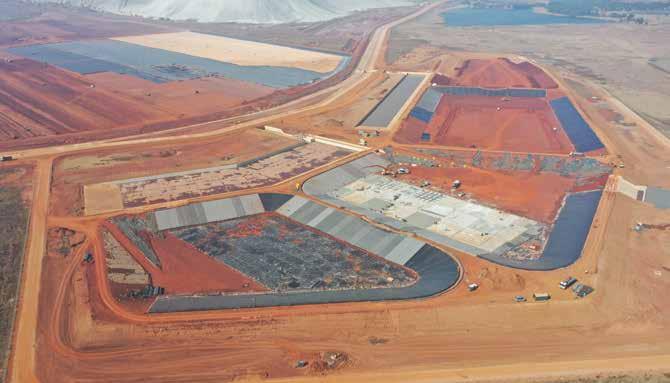
SOUTH AFRICAN b UILDER march 2024 30 projects
(Above): Pierre van Vuuren, Concor project manager.
The project area extends some 2,5km x 3km.

materials are being used in a double-layered low permeability clay for base protection, topped with carefully selected river sand to prevent liner damage. Cutting-edge drainage and leachate collection systems are incorporated to manage water flow efficiently, emphasising sustainability with dirty water reuse for dust suppression and other ADF activities.
Concor's innovative approach in basin construction employs a patented PVC concrete formwork system, boosting efficiency by accelerating the casting panel process. This technique saves both time and labour.
Jansen van Vuuren says that leak prevention is paramount, with electronic leak detection ensuring
construction integrity. “Our teams maintain open communication, emphasising the importance of the quality and structural integrity of the project,” he adds.
Challenges notwithstanding, the project is gearing up to finalise the liner system installation before the rainy season, with subcontractor Aquatan managing the basins and the ADF concurrently.
Highlighting the human element, Jansen van Vuuren praises the skilled workforce, noting that 852 locals have received training and the project’s local procurement achievement stands at a remarkable 55%.
He says this involvement extends beyond labour and is aligned with Eskom and the joint venture’s
CSI strategies, which aim to give back to the local communities. By identifying local community recipients and working together with the contractors on its projects, Eskom ensures that upliftment is extended beyond just employment opportunities.
A good example associated with the Kendal ADF project was the adding of modular classrooms using containers and the fitting out of a kitchen at a local primary school by the joint venture in conjunction with Eskom, thus addressing other community needs, such as education and nutrition.
march 2024 SOUTH AFRICAN b UILDER 31
projects
(Above): Two HDPE-lined earth dams hold clean water, while two similar dams will hold polluted water.
jda's orange farm transport facility
The Orange Farm Public Transport Facility is poised to reform public transport in the area, prioritising safety, sustainability and accessibility for all commuters, including those with disabilities.
The Johannesburg Development Agency (JDA), the City of Johannesburg’s infrastructure arm, has made significant progress on the R49 million facility, now at 60% progress.
Through this development, the city commits to connecting the metropolitan to enhance public transit. The state-of-the-art facility promises to be both functionally robust and aesthetically pleasing, embodying a commitment to ongoing urban development initiatives.
This project is designed to meet the diverse needs of commuters, with a special focus on the disabled, women and children. The facility will boast essential features such as holding bays, loading bays, wash bays, trader stalls and ablution facilities catering for disabled users. Moreover, a public square with a sitting area will create a vibrant hub for traders and the community.
The Orange Farm Public Transport Facility aligns seamlessly with the City of Johannesburg’s broader vision for improved connectivity. Nestled along crucial arterials, the facility will enhance mobility within the city and significantly expand public transport options.
The strategic location at the corner of Link Road and St Patrick’s Road will make the facility a cornerstone for efficient and accessible transportation services.
Ensuring the safety of commuters remains a paramount priority in
the project. The Orange Farm Public Transport Facility has been meticulously designed to create a secure environment for all users.
By incorporating features such as well-lit spaces, designated holding areas and comprehensive ablution facilities, the facility aims to instil confidence in every commuter, making public transport a reliable and secure mode of travel.
As the Orange Farm Public Transport Facility advances, the JDA underscores its commitment to empowering local communities
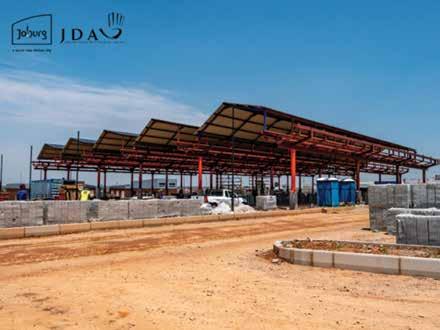
SOUTH AFRICAN b UILDER march 2024 32
projects
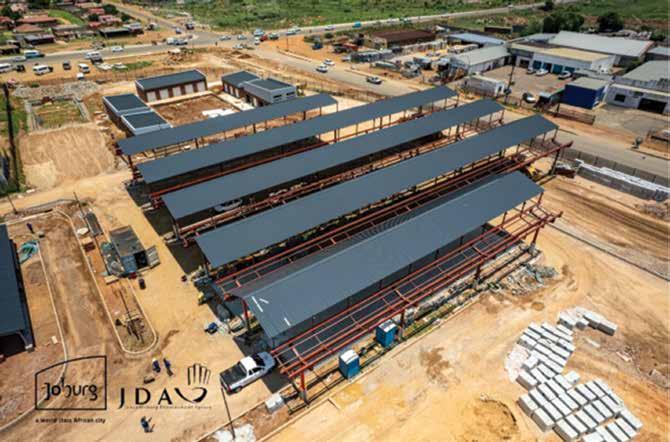
through strategic infrastructure development.
Its mission directs the project team to create a conducive environment for economic empowerment and makes use of programmes for the development of SMMEs. The project has created employment opportunities for the community. A total of 12 local SMMEs and 63 local labourers have been on the project.
“The Orange Farm Public Transport Facility isn’t just a construction project – it’s a testament to our commitment to fostering a city where mobility’s seamless, safety is paramount and every citizen, regardless of age or
ability, can participate fully in the economy,” says JDA acting CEO Siyabonga Genu.
“our priority is the safety of our commuters.”

projects MARCH 2024 SOUTH AFRICAN b UILDER 33
empowering tomorrow's engineers
By David Sullivan, divisional CEO: LH Marthinusen
Staying at the forefront of technology is crucial for businesses wanting to maintain their competitive edge in today’s rapidly evolving industrial landscape. To achieve this, investing in talent development and equipping the next
generation of engineers with hands-on experience is an invaluable strategy.
For example, there are several key benefits to investing in bespoke motor, fan and transformer maintenance training programmes for both young engineers and industrial companies. On the one hand, investing in young
engineers empowers them to find employment, while on the other, it helps to create the next generation of engineers, providing industries with a sustained skilled workforce.
Addressing South Africa's acute skills shortage is crucial,
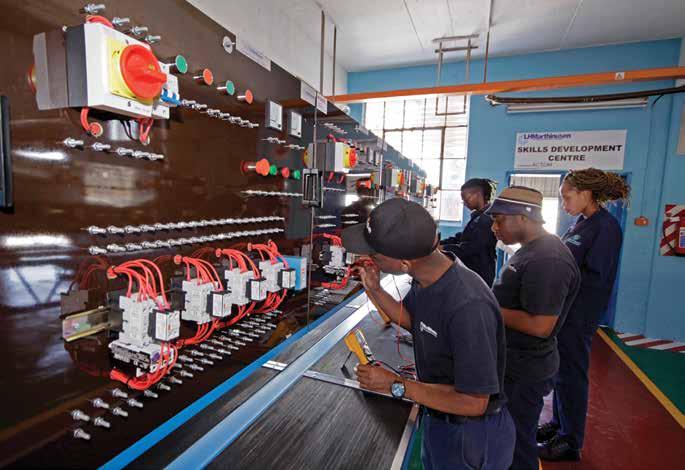
34 SOUTH AFRICAN b UILDER march 2024 skills and training
(Below): Training young apprentices on the factory or shop floor should be a practical gateway to a career in the industry – not a temporary stint.
particularly considering the ongoing loss of qualified personnel through emigration. It is therefore imperative that industrial companies empower and train young engineers to fill these gaps. At the same time, it is important to avoid a situation where businesses invariably compete for a small number of skilled engineers, which would not only drive up the cost of these skills, but also potentially impact the sustainability of industries.
Valuable hands-on experience
Through apprenticeship, young people gain valuable skills that enhance their employability, even if they do not transition to permanent roles within the training company. Meanwhile, companies build a pipeline of talent equipped with both technical expertise and familiarity with their organisational culture. At the end of the training period, the company can select the best talent and incorporate them into positions where they can add value.
Experiential learning is also key to overcoming the challenges faced by most graduates who have the theoretical
knowledge, but lack the practical experience that employers look for in job applicants. Unfortunately, the industry can be hesitant to give individuals with no experience an opportunity, as it is perceived as a greater risk.
However, this perception could be changed if the industry offered young engineers the opportunity to gain a year or two of practical exposure, especially given that the cost of these programmes is not excessive, and funding is available through the various Sector Education Training Authorities. The benefits of experiential programmes to both businesses and graduates far outweigh the costs.
u nderstanding the funding landscape
The first step for industrial
businesses wanting to effectively incorporate these training opportunities into their talent development strategies is to understand what funding is available, particularly for artisans and technologists, as well as the processes that need to be followed and plan for funding upfront.
Another suggestion is for companies to find a mechanism to potentially incentivise mentors on the shop floor – older and more experienced artisans – to take the youngsters under their wing and train them, because companies often hire apprentices merely as cheap labour. At the end of the programme, these apprentices struggle to find jobs, as they have gained little concrete knowledge.

march 2024 SOUTH AFRICAN b UILDER 35
skills and training
have you outgrown your payroll software?
Managing your company’s payroll should be a seamless experience, but if your payroll department is constantly in a state of crisis management, it’s highly likely that the payroll solution you’re using is no longer capable of meeting the organisation’s evolving business needs.
As a company grows, its payroll processes may become more complex – and the payroll system needs to be able to keep pace with that, says Ian McAlister, general manager of CRS Technologies, the authorised distributor of the Engage™ HR and payroll suite.
“However, if the current payroll solution is struggling to handle increased employee numbers, different pay structures or additional benefits, and administrators are being forced to resort to manual processes and spreadsheets to perform payrollrelated tasks, the chances are good that the system’s outlived its usefulness. This is when paydays start becoming a nightmare of never-ending delays and queries about late and inaccurately paid salaries.”
adaptability is key
Additionally, he says, an inability by the system to adapt to changing payroll legislation could expose the company to risks of errors or noncompliance. “Besides the financial ramifications, the reputational
damage to the organisation can be monumental, as trust in the company wanes and, with it, employee morale.
“Consequently, it’s important to invest in a payroll solution that has the capability not only to accommodate the company’s current size, but also its future growth.”
McAlister cites several must-have solution components which are critical to ensuring the company’s payroll is never at risk:
scalability
Scalability is key. A scalable payroll system ensures that the organisation can adapt to growth, regulatory changes and technological advancements.
reporting and analytics
Comprehensive reporting and analytics tools play a crucial role in providing insights and facilitating decision-making. The ability to analyse payroll data empowers organisations to optimise their payroll processes, manage costs and remain legislatively compliant.
integration
Seamless integration with other HR and accounting systems reduces the need to capture information manually, which in turn minimises errors. Thus data becomes more accurate and operational efficiency is enhanced.
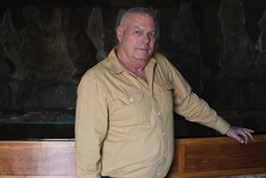
security
The information stored in a payroll system is extremely sensitive, which calls for robust security features. The system must have the correct safeguards in place to ensure that data integrity is never compromised.
Employee self-service
Today’s employees want to be able to do certain HR-related tasks for themselves, such as viewing salary slips, updating personal information, applying for leave and managing benefits. Consequently, the solution should also incorporate an employee self-service system, so that staff can interact with the organisation’s human capital systems at their convenience – on any Internet-enabled device and from any location.
“Payroll is the lifeblood of running a successful company and payroll software plays a pivotal role in managing a growing organisation. Only by investing in the right solution can companies enjoy the benefits of reduced cost- and timesavings, together with enhanced employee and management satisfaction and experience,” says McAlister.
business
36 SOUTH AFRICAN b UILDER march 2024
(Above): Ian McAlister, general manager of CRS Technologies.
Big forks for all loads

B&B provides a variety of specialist big forks for forklift truck requirements. Regardless of the load to be moved or the type of fork connection, the company offers capacities ranging from 1 000-60 000kg, with mountings to cover standard ISO class carriages to bespoke connections.
B&B’s big forks are specially forged to handle the largest loads and are ideal for applications within heavy lifting environments, especially in the timber industry, steel plants and port/stevedore operations.
Large forks are often made of specialist steel with extra hardening and can be manufactured to customers’ requirements, with various lengths and sizes to suit.
The B&B specialist sales team can survey and measure clients’ requirements and offer customised solutions to suit every task, from unusual fork sections and tapers to once-off bespoke construction. The company has heavy-duty forks for every application, from pin to roller and terminal west mounting. It also promises speedy delivery.
B&B. E-mail: info@bandbattachments.com.
Visit:
www.bandbattachments.com
products
march 2024 SOUTH AFRICAN b UILDER 37
Forged to handle the largest loads: one of B&B’s big forks.

admixtures for every season
When ambient temperatures become very hot or cold, concrete users can struggle to achieve the required strength and workability. However, there are admixtures to overcome these challenges.
Patrick Flannigan, technical manager at Chryso Southern Africa, explains that high temperatures cause concrete to develop higher initial strength, but reduce the
strength development over the long term. Very cold weather creates the opposite effect, causing lower strength gain initially, but higher strength gain later.
When temperatures drop below 5°C, the slower hydration process could even cause extended bleeding. At temperatures lower than that, the water in the concrete could freeze. When it does, it
expands by 9%, which means it could cause cracking if the concrete has not reached sufficient strength. “To deal with very hot weather, customers use our Chryso® Tard range of plasticisers, which ensures enough open time,” says Flannigan. “This retarder slows down the hydration of cement by momentarily blocking the surface of the cement particles and delaying the time of initial setting.”
SOUTH AFRICAN b UILDER march 2024 products 38
Chryso plasticisers allow a mix design to be optimised, giving more open time to the fresh concrete.
For cold weather, he recommends the Chryso® XEL range of chloride and non-chloride accelerators, which help with early strength gain of concrete. To deal with the risk of water freezing in the concrete, Chryso® Air helps by adding extra air to the mix. Instead of cracking the concrete, the freezing water will expand into the capillary
openings that the air entrainer has created. These low temperatures are not that common in South Africa, but more relevant to higher elevated areas, such as the Lesotho Highlands.
“Another form of extreme weather causing challenges with concrete is heavy rainfall that causes flooding,”
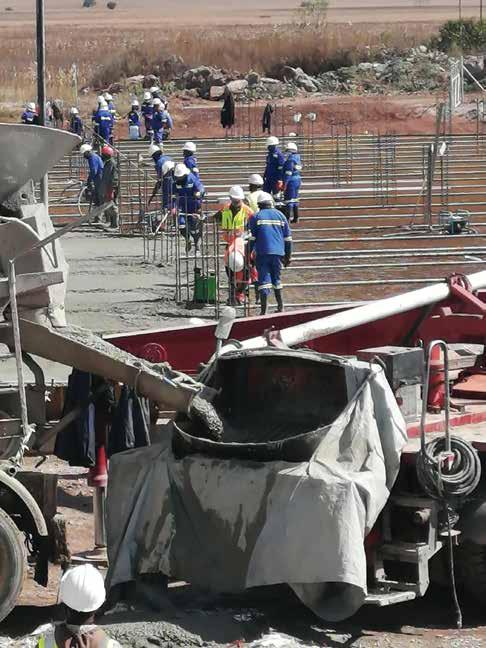

says Flannigan. “Protecting concrete in rainy conditions is crucial in order to prevent surface blemishes on exposed areas. Chryso® Aquabeton is the ideal solution for this, as well as for concrete that needs to be placed underwater, allowing it to be cast in standing or flowing water.”
He adds that Chryso’s solutions are driven not only by functionality, but by a global commitment to sustainability. The company develops admixtures specially for certain types of cement and construction material. This allows a wider range of material to be sourced close to site, even if it is high in clay content, for example.
“This reduces the distances that material needs to be transported and therefore keeps vehicle carbon emissions to a minimum,” he says.
march 2024 SOUTH AFRICAN b UILDER
39 products
(Above): Patrick Flannigan, technical manager: Chryso Southern Africa.
(Left): Chryso plasticising admixtures ensure workability beyond 80 minutes, while providing early strength gain.
debunking the myths about drywall in homes
When talking about construction and renovation in South Africa, homeowners, builders and even architects are more inclined to focus on bricks and mortar than lightweight material options like drywall. As a leader in lightweight construction building materials, Saint-Gobain Africa recently conducted a poll to understand why this is the case and to debunk some of the myths relating to using drywall within the home.
“Internationally, drywall is used in most homes, both at the start of construction and for renovation purposes,” explains Asaad Manjoo from Gyproc SA, a division of SaintGobain Africa. “In SA, where the residential market makes up 52% of the building market, one of the main reasons people don’t use drywall is the misconception that it’s a cheap alternative and doesn’t offer the same quality overall that a bricks-and-mortar wall does.”
Among their perceived drawbacks, drywall options are believed to offer less privacy and insulation, resulting in a home that looks shabby. The reality is that by using good-quality drywall products, a home can have all the benefits of bricks-and-mortar builds with the convenience and simplicity of lightweight construction materials.
the benefits of using drywalling include:

• Less mess and dust – drywalling is done three to four times faster than standard masonry construction, leaving less mess and dust and allowing a renovation to be completed quickly and efficiently.
• Drywall offers great design flexibility, with ease of construction that saves money in the long run. For example, those who buy their homes at an early stage in their lives find that their needs change as the years go by.
SOUTH AFRICAN b UILDER march 2024 40 products
Covid-19 showed us how quickly people needed to turn a room or garage into a study so that they could work from home. Now that we’re back in the office, we might need to return that room to its original state. Drywall is also eight to 10 times lighter than standard masonry construction, meaning it places less pressure on foundations.
• With traditional bricks and mortar, it is relatively difficult to complete renovations, as the internal walls require foundational support. Drywall systems for internal walls do not require this and also result in a cleaner work site.
• Contrary to what 79% of people polled thought, drywall is extremely durable, with solutions that allow one to easily hang heavy objects (such as TV stands, large smart TVs, paintings, kitchen cabinets, etc) directly on walls without additional noggins.
• In residential estates or townhouses, residents are frequently disturbed by the sounds of neighbours arguing, entertaining or playing loud music. Using a drywall system (plasterboard plus insulation) offers better acoustic performance than brick walls, so noise is not a problem.
• Using drywall is also more sustainable, as less water is required in its construction process than for bricks and mortar. Furthermore, the drywall material is made from recyclable materials.
• Aesthetically, drywalls are crack-free, allowing ease of decoration.
• High-performing drywall is also fireresistant.
For further information on drywalling as a home option, visit: www.gyproc.co.za.

march 2024 SOUTH AFRICAN b UILDER
off-site construction a key trend for 2024
The global off-site construction market is projected to top $235 billion by 2030, signifying a compound annual growth rate of almost 6% in the period from 2021-2030. This should hardly come as a surprise, as the construction sector starts embracing modern industrial techniques to “mass-produce” components before reaching the building site.
In fact, off-site construction is characterised by the assembly
of building components in a controlled factory environment before installation on-site. With this come several advantages, such as enhanced efficiency in construction processes and a marked improvement in overall project timelines.
“As sustainability becomes a focus area for many consumers and companies worldwide, offsite construction brings with it several environmental advantages as well,” says Morag Evans, CEO
of Databuild. “These include reduced waste and lower carbon footprints, which align directly with global sustainability goals. If anything, off-site construction is becoming a responsible choice in the face of climate challenges, with builders starting to embrace it wholeheartedly.”
Almost 10 years ago, off-site construction was shown to help drive a more sustainable message while still delivering on the triple bottom line. Despite, this, it was

innovation 42 SOUTH AFRICAN b UILDER march 2024

still considered to be a niche approach. More recently, though, mindsets have begun changing.
The economic benefits of going this route are significant and have proven to be a catalyst to moving this method into the mainstream. For instance, reduced labour costs and shorter project timelines translate into massive cost-savings. At a time when economic uncertainties are limiting construction budgets, the financial advantages are proving to be an attractive option. There are also labour shortages to consider which can be mitigated by this “mass-production” methodology.
“Of course, challenges remain. Take transportation logistics,
for example. This is a significant concern in widely dispersed markets like South Africa, where development in outlying areas can make transport an issue to get pre-fab components from factory to site as cost-effectively as possible,” says Evans.
There is also the initial investment in reconfiguring factories that must be better geared to handle off-site manufacturing components. However, despite these hurdles, the global construction industry is increasingly recognising the long-term value and sustainability benefits of the trend.
An example of how off-site construction can be practically implemented is that of modular or
“box” homes. These can be built in smaller modules at an off-site (read: factory) location. They are then transported to the property and installed. While they have yet to gain widespread adoption, they have become popular in developed markets like North America and Europe.
“This could very well be a defining year for off-site construction not only in SA, but in the rest of the world. As we turn towards more sustainable, efficient and costeffective building practices, going the off-site route might very well be the breath of fresh air the sector needs,” says Evans.
“sustainability is the focus.”
43 march 2024 SOUTH AFRICAN b UILDER innovatoin
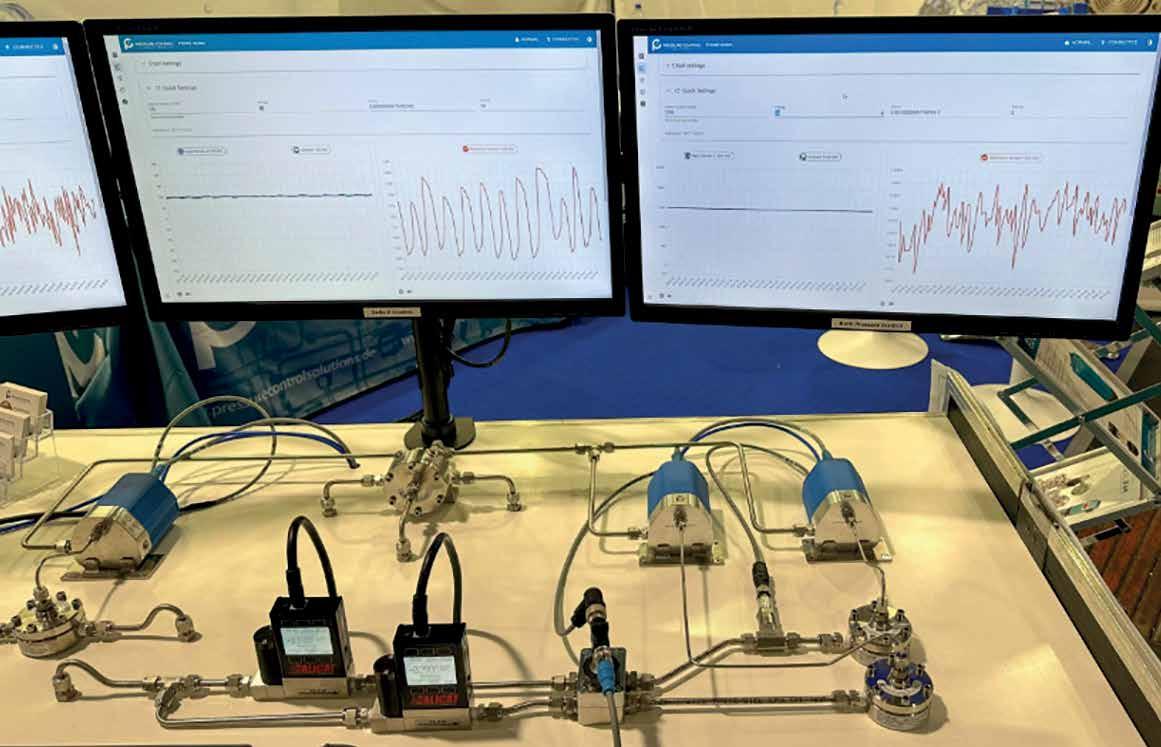
hydrogen meets keller's golds
Keller manufactures isolated piezoresistive pressure sensors for the type of pressure measurements invented by the organisation’s founder, Hannes W Keller.
The great advantage of the piezoresistive measuring principle is its high stability. The chip that measures the pressure is installed in an oil-filled cylinder and sealed by a steel diaphragm. This ensures the best possible isolation.
The piezoresistive pressure sensor is also considered one of the most stable for hydrogen applications. Without additional actions, however, an oil-filled sensor can also have a disadvantage. In certain
circumstances, hydrogen molecules can split into two hydrogen atoms at higher temperatures. These atoms are smaller than the pores of the steel membrane. This allows the atoms to penetrate through the membrane into the oil chamber of the pressure sensor. In the oil chamber, they fuse again to form a hydrogen gas molecule (H2), which leads to offset errors due to the expansion. The offset is called the “signal deviation” of the target value. After all, it must be considered that the medium is gas. The phenomenon described is called “permeation”.
For this reason, Keller uses goldplated steel membranes for
hydrogen pressure sensors. Gold has much smaller pores than stainless steel. The hydrogen can hardly penetrate the gold layer. This defusing action, together with fully welded sensors that have no internal seals, confirms Keller’s competence and strength in the pressure sensor market, including for hydrogen applications. The typical pressure ranges for applications with hydrogen are from 0-2 bar to 0-1 000 bar.
Keller offers the precise and most suitable sensors for these applications. In addition, the hydrogen pressure sensors are compatible with the EC79 standard for automotive applications.
SOUTH AFRICAN b UILDER march 2024 44
innovation
february is workplace violence
 By Zenzele Mabuza, MBSA OHS manager
By Zenzele Mabuza, MBSA OHS manager
Some 77,8% of South Africans say they have experienced some form of victimisation during their careers. This was determined in an Internet survey in 2000. However, bullying is persistent, prolonged, humiliating, damaging, vindictive and cruel, and can be either overt or covert with a definite impact on the well-being of the victim. Sometimes people confuse conflict with bullying, but new research indicates that the incidence of workplace bullying is over 20% in the health sector. The form and incidence also differ between the public and the private sectors.
t he most frequently reported incidents in the workplace are:
• Talking about someone behind their back.
• Interrupting others while they are speaking or working.
• Flaunting status or authority; acting in a condescending manner.
• Belittling someone’s opinion.
• Mood swings.
• Failing to return phone calls or respond to memos.
• Giving others the silent treatment.
• Insults, yelling, swearing, name-calling, threats,
awareness month
shouting, rude gestures and aggressive posturing.
• Staring, dirty looks, looking “over” someone, avoiding eye contact or eye-rolling.
• Intentionally damning with faint praise.
• Undermining actions by a coworker.
• Spreading stories and halftruths.
• Humiliating an employee in the presence of others.
• Ridicule, teasing and sarcasm.
• Overloading a person with work as a form of punishment.
• Refusing a person’s rights or privileges.
• False accusations.
• “Stealing” subordinates’ work.
• Deceiving or setting someone up.
• Harassment, including sexual and racial abuse.
• Intimidation.
• Leaving offensive messages.
• Interfering with work tools and equipment.
w hat are the causes of workplace violence?
• This depends on the psychological make-up of the perpetrator. Only 2-4% of them perpetrators are sociopaths, but because
of their personality traits, they influence a much larger percentage of people. Most other perpetrators present with equally harmful survival behaviour.
• Economic conditions which may impact the social status of the victim.
• If corporate culture permits and rewards hostile behaviour, then that means it is a part of leadership and managerial practice. There should be strong anti-bullying policies and intervention strategies. Yet even when the corporate culture is co-operative, workplace hostilities go “underground” and it takes a watchful eye to detect it.
• Managerial factors like deficiency in work design, inappropriate and inadequate communication, low moral standards, lack of stimulating and challenging tasks, poor supervisors, frustrations and conflicts relating to rights, obligations, privileges, position, poor interpersonal relationships and the need for a suitable scapegoat.
• The encouragement of bullying management styles.
• Changes like restructuring, looming retrenchments and mergers can spark workplace wars in a normally peaceful environment.
To address and prevent workplace violence in your organisation, you need to know what to look for.
march 2024 SOUTH AFRICAN b UILDER 45 mbsa
mbsa
Here are the different types of workplace violence:
g uiding questions:
• What are the signs of potential workplace violence?
• Where can your employees hide if violence breaks out in your workplace?
• Who on site would need to be notified about any workplace violence?
• What specific types of workplace violence might your business face?
types of workplace violence
• Criminal intent: These are crimes that are committed against a business and its property. The people committing the crime have no relationship with the business or its employees.
• Customer/Client: A customer or client who becomes violent or threatening while interacting with the business.
• worker-on-worker: This type of workplace violence is perpetrated by a current or past employee who attacks or threatens another employee. An employee is upset because they believe they are not being treated fairly by management and lashes out violently against a team member.
• personal relationships: Generally, this perpetrator has a personal relationship with the victim (but not the business). Women are overwhelmingly victims in this category. It can also
be considered as domestic violence if the parties live together.
workplace violence risk factors
Workplace violence incidents are not experienced evenly across all businesses. Scenarios that place employees at higher risk include workers leaving late at night and businesses located in highcrime areas.
steps to Combat workplace violence
step #1: Create a workplace violence prevention programme
Create a policy for employees that outlines what is unacceptable behaviour, including gender or racial discrimination, drug and alcohol use, and safety procedures. Distribute the policies to all levels of the workplace, including employees, managers, leadership and contract workers. In addition, make sure you carefully establish a complaint process and communicate this process in your policies.
step #2: a ssess and improve physical security
Ensure the premises have proper lighting, security and even data security (to prevent unauthorised use of employer computer systems).
step #3: l imit access to non-employees
Strangers with no relationship to the company commit 85% of workplace homicides. Employers should limit visitors who have no business being on site by
ensuring that no doors or gates are left unsecured.
step #4: train employees in situational awareness
Set up training sessions to help employees understand the threat of intruders and the very real risks they present. In addition, encourage employees to report suspicious visitors or potential acts of violence. Ensure they know who to notify.
step #5: Ensure lone workers are protected
Lone workers should be equipped with life-saving communication equipment.
step #6: Communicate effectively
Relating critical information is vital in preventing workplace violence. Make sure teams meet regularly to discuss air any unresolved tensions or disagreements. By doing so, employees can ease strained relationships that could culminate in bullying or violence.
Final thoughts
It is every employer’s responsibility to put plans in place to prevent all types of workplace bullying and violence. Take steps now to mitigate the risk of danger and improve overall workplace well-being and safety.

46 SOUTH AFRICAN b UILDER march 2024
captains of construction
mba rEgional listing and aFFiliatE mEmbErs









Master Builders Association
Boland
Contact: Daniel Uys info@mbaboland.org.za 021 863 3330
Master Builders Association
East Cape
Contact: Greg Steele ecmba@global.co.za 041 365 1835
Master Builders Association
Free State
Contact: Stephan Claassen admin@mbafs.co.za 057 352 6269
Master Builders Association
Greater Boland
Contact: Duane Phillips info@mbagreaterboland.org.za 023 342 6964
Master Builders Association
KwaZulu-Natal
Contact: Vikashnee Harbhajan info@masterbuilders.co.za 031 266 7070
Master Builders Association
North
Contact: Mohau Mphomela info@mbanorth.co.za 011 805 6611
Master Builders Association
Northern Cape
Contact: Graham Andrews info@mbanc.org.za 053 832 1762
Master Builders Association
Western Cape
Contact: Mark Fugard info@mbawc.org.za 021 685 2625
Association of Architectural Aluminium Manufacturers of SA
Contact: Johan Heyneke reception@aaamsa.co.za 011 805 5002
s traight chuter

richard hugh sales manager: africa for superb flooring/
construction systems/psa
With a military background spanning some 10 years – which included duty in active battle zones – Richard Hugh: sales manager: Africa for Superb Flooring/Construction Systems/PSA, learnt perseverance and resilience the hard way.
He was a paratrooper with the British military in the 2003 Iraqi war and then served in Northern Ireland in 2004, as well as stints of operational peacekeeping in Afghanistan in 2006.
Having met and married his South African wife in the UK, Hugh immigrated to this country in 2009 and was placed in the Superb Flooring Company by the PSA directors. He then worked his way up the ranks to his present position, where he soon developed a love of the construction industry.
“The part of my job I enjoy most is the travelling it involves,” he says. “As the sales manager for Africa, I’m regularly required to visit different countries in the subcontinent, which is always interesting. I also love networking and meeting new people.”
Despite the current sociopolitical and economic challenges facing the industry – and, indeed, South Africa – he remains optimistic about the future. “The PMSA group has been a leader in the concrete machine manufacturing industry for 48 years and has put a lot of work into research and development and creating new machines. It’s also the sole manufacturer for 3D concrete printing machines. With that kind of legacy and its unassailable reputation for excellence, I’m confident about the company’s success, going forward,” he says.
march 2024 SOUTH AFRICAN b UILDER 47








48 SOUTH AFRICAN b UILDER march 2024 brand supporters brand supporters info@isipani.co.za 021 868 3008 mastEr buildErs south aFriC a (mbsa) www.masterbuilders.org.za info@masterbuilders.org.za 011 205 9000 MODERN DESIGN. MADE THE OLD-FASHIONED WAY. At Swartland, we only know one way to make doors and windows, and that’s to last. Our Kenzo range is built from strong, lightweight aluminium-alloy frames allowing for expansive walls of light, space and seamless integration with nature. Kenzo windows and doors require very little maintenance and never need to be painted – the perfect combination of durability and affordability. All products are SANS 613 certified and compliant. Call us on 086 110 2425 or visit www.swartland.co.za for more info. Kenzo_2022_297x210.indd 1 2022/02/25 15:55 s wartland inVEstmEnts (p t Y ) ltd www.swartland.co.za customerservice@swartland.co.za 086 110 2425 jEssop and assoCiatEs www.protile.co.za info@protile.co.za 016 421 2521 t winstar www.twinstar.co.za annemerie@Twinstar.co.za 012 670 9083 mapEi www.mapei.com info@mapei.co.za 011 552 8476 pmsa www.pmsa.com sales@panmixers.co.za 010 500 2441 mastEr buildErs assoCiation E ast C apE www.ecmba.org.za ecmba@global.co.za 041 365 1835


































































 By Zenzele Mabuza, MBSA OHS manager
By Zenzele Mabuza, MBSA OHS manager


















